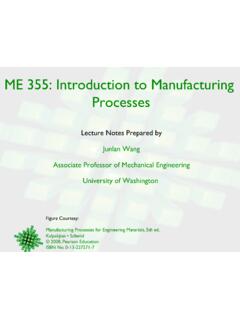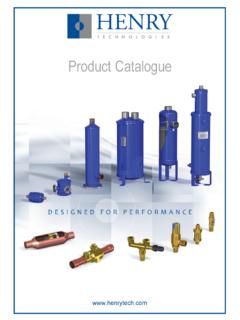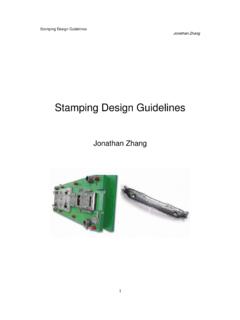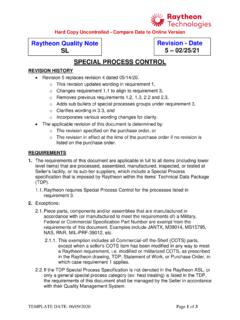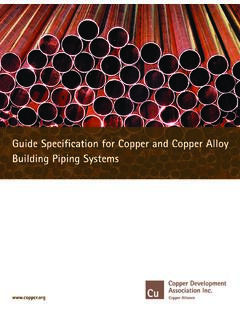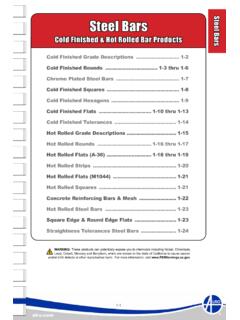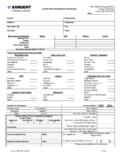Transcription of The Brazing Guide - GH INDUCTION
1 - 1 -The Brazing GuideGH INDUCTION Heating SolutionsThe Brazing GuideBrazing is a method of joining two pieces of metal together with a third, molten filler metal. Of all the methods available for metal joining, Brazing may be the most versatile. The process is relatively fast and economical, requires relatively low temperatures and is highly adaptable to automation and lean manufacturing initiatives. Brazed joints have great tensile strength they are often stronger than the two metals being bonded together. Brazed joints repel gas and liquid, withstand vibration and shock and are unaffected by normal changes in temperature. Because the metals to be joined are not themselves melted, they are not warped or otherwise distorted and retain their original metallurgical this Guide to learn about the different aspects of Brazing and the many advantages offered by this unique Overview.
2 Pg 2 Topics include Brazing basics, when Brazing works best, heat sources for Brazing and types of braze Procedures ..pg 4 Describes the basic process and offers recommendations to improve your Brazing Brazing ..pg 5 Explains how INDUCTION heating can be utilized to produce quick, clean, consistent braze a Brazing Atmosphere ..pg 6 Discusses the relative merits of Brazing in open air, controlled atmospheres and vacuum Comparison Chart ..pg 7 Recommends an atmosphere for the most common combinations of metals being joined and Brazing An 7 Compares characteristics of copper, silver, silver with lithium, nickel, aluminum and Suppliers ..pg 8 Contact information and links to suppliers of Brazing alloys and Equipment ..pg 9GH IA manufactures turnkey Brazing systems for open air, controlled atmosphere and vacuum GH INDUCTION Atmospheres.
3 Pg 10GH IA manufactures turnkey INDUCTION Brazing systems and offers contract Brazing services for steel, stainless steel, aluminum, brass, nickel,superalloys, copper, titanium and INDUCTION Atmospheres 35 Industrial Park Circle, Rochester New York 14624 USA Tel: Fax: 2 -The Brazing GuideGH INDUCTION OverviewWHAT IS Brazing ? Brazing is a method of joining two pieces of metal together with a third, molten filler metal. The joint area is heated above the melting point of the filler metal but below the melting point of the metals being joined; the molten filler metal flows into the gap between the other two metal pieces by capillary action and forms a strong metallurgical bond as it all the methods available for metal joining, Brazing may be the most versatile. Brazed joints have great tensile strength they are often stronger than the two metals being bonded together.
4 Brazed joints repel gas and liquid, withstand vibration and shock and are unaf-fected by normal changes in temperature. Because the metals being joined are not themselves melted, they are not warped or otherwise distorted and retain their original metallurgical brazed joints have a very clean, well-finished appearance, Brazing often is the preferred bonding process for manufacturing plumb-ing fixtures, tools, heavy construction equipment and high- quality consumer products. The process is well-suited for joining dissimilar met-als, which gives the assembly designer more material options. Complex assemblies can be manufactured in stages by using filler metals with progressively lower melting points. Brazing is relatively fast and economical, requires relatively low temperatures and is highly adaptable to automation and lean manufacturing Brazing WORKS BESTA mong the many industrial options for join-ing metal, when does Brazing work best?
5 When considering which metal joining pro-cess to choose for a particular assembly, sev-eral factors should be considered: strength and permanence, the physical characteristics of the parts, the shape of the joint, and the production level shown in Table 1, there are many tech-niques used to join metal: mechanical meth-ods such as threading or bolting, adhesive bonding, soldering, welding and Brazing . Each has its own advantages and or welding are preferred when strength and permanence are primary considerations. Due to the fact that in Brazing a filler metal is always used and generally the entire joint area is heated at the same time, Brazing is a more robust process. This means that the joint clear-ances, fixturing, etc are much more forgiving in Brazing than in welding. If strength is not a determining factor or if the joint may be disassembled in the future soldering, adhesive bonding or a simple mechanical fastening method are likely better Brazing , soldering and welding are similar in many respects, there are important dif-ferences.
6 Soldering generally can be done at lower temperatures (below 450 C), but does not produce as strong a joint. Welding, a higher-temperature process in which the two metals to be joined are actually melted and fused together, requires the most heat energy. Welded and brazed joints are usually at least as strong as the metals being joined. The welding process is ideal for applications which benefit from highly localized, pinpoint heating. But it is more difficult to apply to linear joining, not as easy to automate, and not easily adaptable for joining metals with different melting is also important to consider the physical characteristics of the parts and joint area. Because of its high temperature requirements, welding works best with relatively strong, thick parts MechanicalBondingAdhesiveBondingSolderin gWeldingBrazingEconomyBESTBETTERBETTERGO ODBETTERS trengthGOODGOODBETTERBESTBESTE nergy UsedBESTBETTERBETTERGOODBETTERC ontrolGOODGOODBETTERBESTBESTF lexibilityGOODGOODBETTERBETTERBESTB razed joints have great 1 Brazed provides a clean, well-finished 3 -The Brazing GuideGH INDUCTION can withstand the heat.
7 Brazing , which works at lower temperatures, may be the best choice for thinner parts because metal warpage and distortion can be minimized. Spot joints can be easily welded or brazed, but linear joints are easier to braze because the filler metal naturally flows into the joint Brazing and welding work well for joining metals with similar melting points, but it is generally easier to join dissimilar metals with Brazing . Simply choose a filler metal with a lower melting point than either of the metals to be joined. While welding is difficult to automate partially or in stages, Brazing is a more flexible process; pre-fluxing and pre-positioning sta-tions can be set up to increase speed for high throughput requirements, or a conveyor can be used to transport groups of parts past the Brazing for many metal joining procedures, Brazing becomes the most logical solution.
8 The ad-vantages and flexibility that Brazing offers are most fully realized when the heating process is carefully considered at the assembly design stage. Parts once visualized and manufactured as monolithic, one-piece units machined out of solid bar stock can be often be produced more quickly and economically by Brazing together one or more metal components. Because a variety of metals can be utilized, Brazing enables designers to optimize component functionality, weight and economy. Expensive machining, casting and forging processes can be eliminated without compromising the integrity of the part, and lower cost raw materials such as sheet metal, extrusions and stampings can be utilized. The manufacturing process becomes leaner, faster and ultimately more SOURCES FOR BRAZINGThe heat for Brazing is typically provided by a hand-held torch, a furnace or an INDUCTION heating system.
9 Other techniques include dip Brazing and resistance Brazing is often used for small assemblies and low-volume applications. A neutral flame with a bluish to orange tip, a well-defined bluish white inner cone and no acetylene feather works the best; a flame with a colorless tip can cause oxidation. Although the quality of the joint is largely dependent on operator skill and consistency is sometimes an issue, torch Brazing requires only a small investment and is very Brazing does not required a skilled operator, and is often used to braze many assem-blies at once. This method is only practical if the filler metal can be pre-positioned. Furnaces normally must be left on 24/7 to eliminate long start up and cool down delays, and are notparticularly Brazing is used for small wires, sheets and other components that are small enough to be immersed. The parts are dipped in a molten flux bath which doubles as the heating agent.
10 Resistance Brazing is effective for joining relatively small, highly conductive metal parts. Heat is produced by the resistance of the parts to the heat has the advantages of speed, accuracy and consistency. In a well-designed INDUCTION system, each part is identically positioned in the INDUCTION coil and the filler material is carefully regulated. This type of system consistently and quickly delivers a precise amount of heat to a small area. The INDUCTION heating power supply s internal timer can be used to control cycle time; temperature control feedback for each individual part can be provided with thermocouples, IR thermometers or visual temperature sensors. INDUCTION furnaces are also available for high-volume OF BRAZE JOINTSA lthough there are a wide variety of braze joints to suit varying part and assembly geometries and functions, most braze joints are variations of one of two basic types the butt joint and the lap form a butt joint, the two pieces of metal are positioned in an edge to edge, in an end-to-end arrangement as shown on Page 4.

